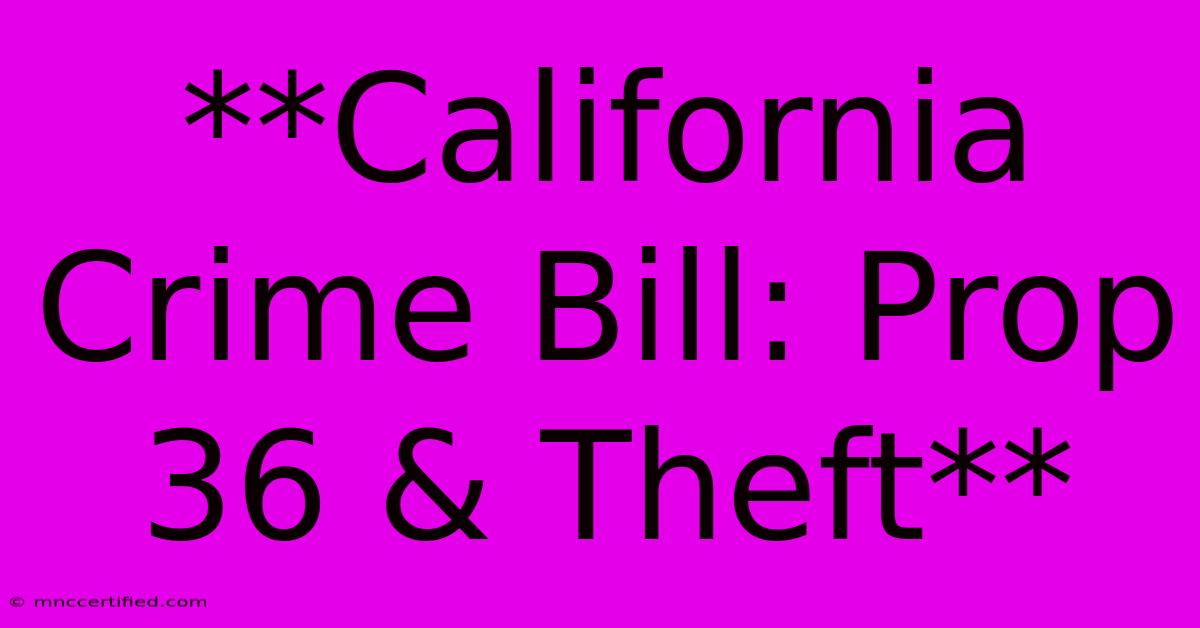**California Crime Bill: Prop 36 & Theft**

Table of Contents
Understanding California's Prop 36: The Impact on Theft and its Implications
California's Prop 36, officially known as the "Three Strikes, You're Out" Reform Act of 2012, has been a landmark piece of legislation impacting the state's criminal justice system. While its primary focus was on reducing the state's prison population, the law also had a significant impact on how theft is handled.
This article delves into the nuances of Prop 36, explaining its key provisions related to theft, its intended and unintended consequences, and the ongoing debate surrounding its effectiveness.
Key Provisions of Prop 36 Affecting Theft
Prop 36 introduced several key changes concerning theft:
- Reduced Sentences: The law made it possible for certain nonviolent offenders, including those convicted of theft, to be eligible for early release. This was achieved by reclassifying some offenses from felonies to misdemeanors and offering alternative sentencing options.
- Focus on Rehabilitation: Prop 36 emphasized rehabilitation programs, providing offenders with opportunities for drug treatment, mental health counseling, and job training to reduce recidivism rates.
- Increased Focus on Alternative Sentencing: The law encouraged the use of alternative sentencing options, such as probation and community service, instead of incarceration for certain theft offenses.
The Impact of Prop 36 on Theft Crime Rates
The impact of Prop 36 on theft crime rates remains a topic of ongoing debate and research. Some argue that the law's emphasis on rehabilitation and reduced sentences has led to an increase in theft crimes. Others, however, suggest that the rise in theft might be attributed to broader societal factors, such as economic hardship and the opioid epidemic.
It's essential to recognize that:
- Data can be complex and open to interpretation.
- Correlating Prop 36 with specific crime trends requires careful analysis, considering numerous contributing factors.
The Ongoing Debate: Pros and Cons of Prop 36
Arguments in favor of Prop 36:
- Reduced Prison Population: Prop 36 has helped in significantly reducing California's prison population, leading to cost savings and freeing up resources for rehabilitation programs.
- Focus on Rehabilitation: The emphasis on rehabilitation programs can help offenders transition back into society successfully and reduce recidivism rates.
- Alternative Sentencing: Prop 36 has fostered the use of alternative sentencing options, keeping people out of jail and reducing the strain on the prison system.
Arguments against Prop 36:
- Potential Increase in Crime: Some argue that the reduced sentencing and focus on rehabilitation have emboldened criminals, leading to a rise in property crimes like theft.
- Unintended Consequences: Critics argue that the law's unintended consequences include a perceived sense of leniency towards offenders, potentially encouraging criminal behavior.
- Lack of Sufficient Data: Some argue that there isn't enough data to adequately assess the long-term impact of Prop 36 on crime rates and recidivism.
Moving Forward: The Future of Prop 36
The future of Prop 36 remains uncertain. While it has achieved its goal of reducing California's prison population, its impact on theft crime rates and recidivism is still being debated.
Moving forward, it's crucial to:
- Continue researching the impact of Prop 36 on crime rates and recidivism.
- Examine the effectiveness of rehabilitation programs and alternative sentencing options.
- Develop evidence-based policies that balance public safety with the need for rehabilitation and reduced incarceration.
Conclusion: Prop 36 and the Complexities of Crime
Prop 36 represents a significant shift in California's criminal justice system, prioritizing rehabilitation over punishment. While its impact on theft and other crimes is still being debated, it has sparked vital conversations about criminal justice reform and the role of rehabilitation in reducing recidivism rates. As the debate continues, a holistic approach that considers both public safety and the individual needs of offenders is essential to shaping a more just and effective criminal justice system.

Thank you for visiting our website wich cover about **California Crime Bill: Prop 36 & Theft**. We hope the information provided has been useful to you. Feel free to contact us if you have any questions or need further assistance. See you next time and dont miss to bookmark.
Featured Posts
-
Charlotte Liberty Mutual Insurance Company
Nov 07, 2024
-
Polymarket Election Day Success 240 Million Traded
Nov 07, 2024
-
Live Barcelona Vs Estrella Roja Champions League Match
Nov 07, 2024
-
1000 Ethereum Investment 5 Years Ago The Results
Nov 07, 2024
-
Mc Cain Speaks Out On The Views Politics
Nov 07, 2024